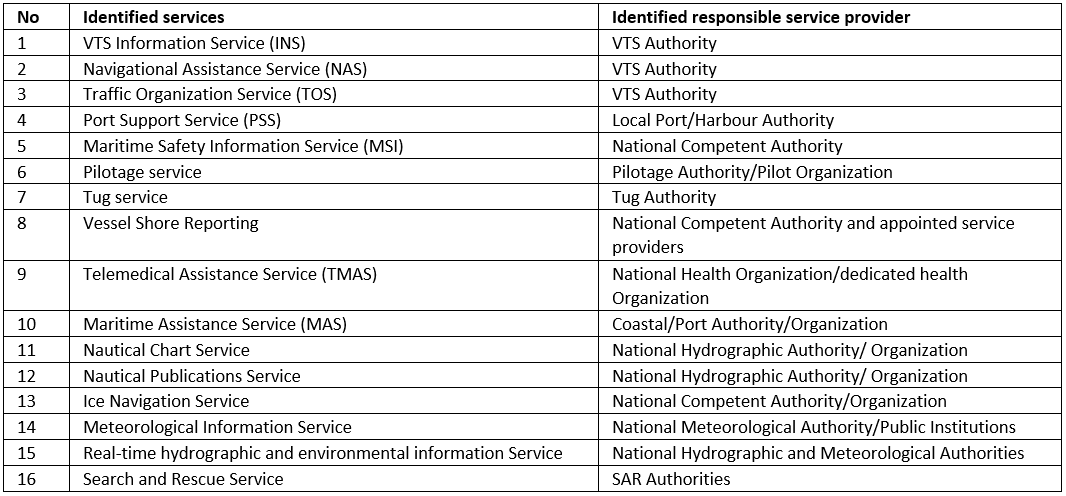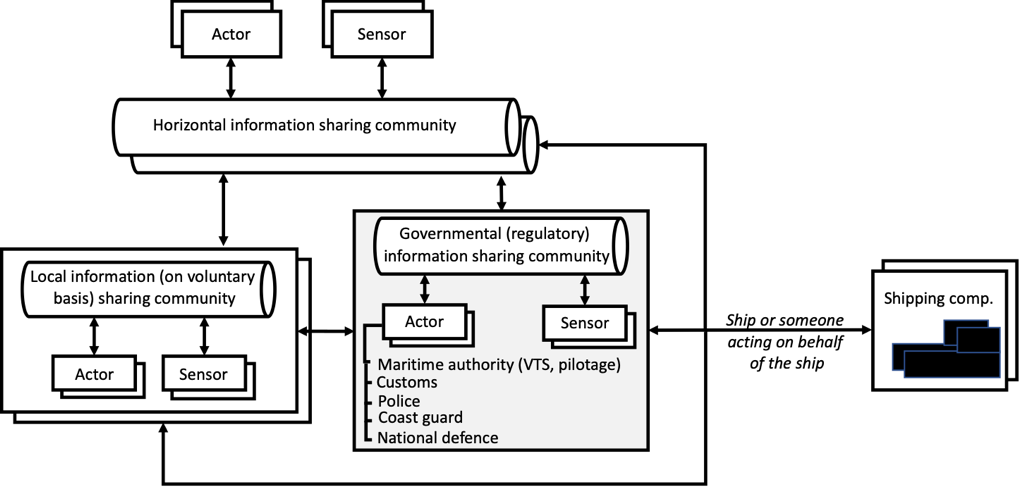Do Maritime Authorities Have a Role in the Digitalization of Shipping?

The ports of the world have an important role in enabling sustainable transport through the combination of multiple transport means. In this regard, a port needs to be seen as a transhipment hub catering for the needs of multiple transport modes that engages many different actors; private and public.
With digitalization now entering the maritime and transport sector at an ever increasing pace, attention is now being paid to ensuring that the different modes of transport are much better connected to overcome the coordination and synchronization challenges that arise from port visits.
In the emerging digital landscape, the different parties engaged along the transport chain need to take action to improve their coordination and synchronization by sharing the information upon which they have a mutual dependency. One initiative is to adopt message standards and standardized interfaces for the exchange of relevant information of mutual interest and benefit, another is the provision of operational data sharing environments to do this. For the latter, several initiatives are underway to establish information sharing communities empowered by data sharing platforms (data pipelines), at the same time fulfilling the needs of information transparency among the involved actors.
An increasing number of maritime and port authorities are now engaged in empowering digital collaboration among the actors in sea transport, and especially in relation to port operations, resulting in a redefinition of the role that different actors, such as the ship agent, take in assuring sustainable maritime transport operations. Examples of such efforts are in the European Maritime Single Window legislation with the aim to harmonize reporting to authorities, and the adoption of port community systems (PCS) with the aim of supporting the administrative processes associated with port operations. These approaches mean that “information islands” emerge that need to be connected. Regardless whether the data sharing is to be pursued on a voluntary or a regulatory basis, different information sharing environments engaging a selected group of actors need to be connected to secure information transparency along the transport chain.
In this article, we highlight the Swedish “Digital (port) approach” as an example of the actions that a maritime authority can take to ease the burden of regulatory reporting along the maritime supply chain. This approach is a response to the fact that all port visits made in Europe and internationally must now be able to use digital means to meet their reporting obligations.
Emerging requirements and obligations for digital data sharing
Digital reporting
After concluding that its 2010/65 directive to simplify and harmonize the administrative procedures applied to maritime transport by making the electronic transmission of information standard and by rationalising reporting formalities would not fully achieve the desired result, the EC put forward a new legislation for a European maritime single window environment (eMSWe). The aim of this legislation is to achieve harmonisztion (mainly on machine-to-machine communication) that is currently in the phase of developing delegated and implemented acts to support the implementation of the legislation.
All member states will implement the legislation with a scope that is more than the 2010/65 directive by including specific reporting obligations to ports. It will be implemented in August 2025. The impact of this highlights the need for increased collaboration between the stakeholders engaged in port visits.
Digitally enabled maritime services
Within IMO, the development of 16 maritime services under its concept of e-navigation is ongoing. These 16 maritime services can be seen as a set of “service products” being provided by a stakeholder in a given “sea area, waterway, or port as appropriate”. To help the development, IMO is also working on the harmonization of structures and formats for digitally transmitted data. As the table below reveals, the provision of these (digital) maritime services will be provided by both private and public actors.

Table 1. Maritime service with responsible service providers
Many of the maritime services listed in the table above would be provided by a national maritime authority, such as the Swedish Maritime Administration.
Connected information sharing communities
The information services and obligations listed earlier depend on the provision of information that is conceived and described in a standardized and commonly agreed way. It can come from various reliable sources and can then be made available for many uses. One example is an estimated time of arrival (ETA). The source for an ETA could be a part of a message provided by a shipping company to the authority, or by a (private) terminal operator. Independent of who provides the information the other party (the authority and/or the terminal operator) would like to ensure that they have the same information which also can be continually updated according to the progress of a voyage. Connecting various different actors with common interests in this way, digitalization enables the same information to be reported only once and then used by all actors with access and a need to know.
This trend points towards stakeholders associated with sea transport and/or port visits being connected through information sharing communities becoming essential thereby ensuring that data can be exchanged among those communities.
The Swedish Digital Approach Concept
The Swedish maritime transport setting
The 3,218 Km of Swedish coastline contains a number of ports, each serving as transport interfaces to different regions of the country. Many of those 52 Swedish ports serve local industries in enabling the import and export of goods. Lately, strategies have been formed to make a shift from serving those industries by the road and railway systems to using sea-borne transport, thereby relieving the presently overburdened hinterland transport system to concentrate more on “last mile transport”.
Historically, different initiatives have been taken to encourage digital collaboration among stakeholders within the port, both administratively through the PCS as well as the forthcoming implementation of port call optimization concepts for the operational coordination and synchronization of port call operations. Those concepts seek to align with traffic and logistics management across different modes of transports.
There is a close relationship between the national maritime authority and port authorities serving the ports in Sweden. The maritime authority is responsible for the national seaways and operates the Vessel Traffic System (VTS), while port authorities are responsible for the waters within their port areas. Sometimes maritime authorities provide pilot services supporting a ship’s passage to/from the berth.
The close relationship between the maritime and the port authority is particularly evident in Gothenburg, the largest port in Scandinavia, which is an organizational entity in which the Swedish Maritime Administration and the Port Authority of Port of Gothenburg work closely together utilising each other’s insights and capabilities. The maritime authority has recognized that it has a role to play in collecting data based on legal requirements, but that data could also be used for other administrative and operational purposes among diverse stakeholders who also can collect other data that can be input to the completion of the reporting requirements. This is the fundamental concept of reporting data once – and then using it many times.
Inter-connected communities for regulatory and voluntary data sharing
The Swedish Digital Approach concept aims at serving the sea window of the port to ease the administrative burden for ships making visits to Swedish ports as well as making the whole approach more effective. The concept builds upon consuming data from multiple sources as well as providing data to private and public actors. The scope of the regulatory information community provided and maintained by the Swedish maritime authority is centerd around the need for managing the reporting obligations that need to be met for all visits to Swedish waters and ports. An important foundation for the Swedish Digital Approach is for it to be an integrated part of the transport system as a whole and thereby enable the development of smart ships and smart ports.
As required in the eMSWe legislation, there are numerous information pieces associated to the ship and the cargo / passengers / crew that the ship carries that need to be reported to different recipients (such as the coast guard, the police, national defence, and customs) in order for receive clearance to enter a port. At the core of the digital approach is the establishment of a regulatory information sharing community positioned in relation to other local information sharing communities and horizontal information sharing communities (as in figure 1, below). This principle architecture of the relationship between different types of information sharing communities reflects the communication flow emerging from processes necessary for organizing and fulfilling efficient and sustainable end-to-end supply chains.

Figure 1: Governmental (regulative) information sharing community in the context of local and horizontal information sharing communities
A typical local information sharing community is the actors within a port exchanging information and a typical horizontal information sharing community is the particular actors involved in an end-to-end supply chain. The Swedish Digital Approach, as a governmental initiative, is fully aligned with the European project FEDeRATED of which Sweden is a core partner, following the European Commission’s concept of a federated network of platforms for digitally integrated supply chains.
Third-party provision of maritime services
The digital maritime services shown above are all require information from diverse actors. A governmental information sharing environment that is connected to other information sharing environments allows the provision of services based on data from multiple sources. For the purpose of providing best-in-class services it is preferred that data is made available from information sharing communities, based on agreed access management principles, to the digital ecosystem of the service providers. These may be in-house capabilities of maritime stakeholders as well as third parties, utilized for the development and possibly the provision of both the maritime services elaborated above and for other services used to support maritime transport.
Final words: The Swedish Digital Approach - a regulative collaboration arena in context
The Swedish Digital Approach aims to meet the emerging legal requirements on reporting formalities as an integrated part of an emerging digital ecosystem of services associated with port visits. At the core of the Swedish Digital Approach is to offer:
- A digital collaborative environment, which is a data sharing environment for the Swedish governmental information sharing community, that
- builds upon agreed standards on messaging and interfaces for data sharing decided upon within IMO/FAL and the European Union
- provides an interface to/from other local information sharing environments, such as port community systems or other types of local information sharing communities that are used by the Swedish ports
- provides an interface to/from horizontal information sharing communities
- provides an interface to/from external stakeholders easing the administrative burden for ship reporting necessary upon visits to Swedish port
- An interface to data for transport stakeholders to enable integration, and to enhance their capabilities and support their services as part of a seamless and sustainable transport chain
Maritime authorities have an important role in the digitalization of shipping, especially as reporting formalities create a significant administrative burden for shipping companies, and their collaborators, as of today. Some larger shipping companies have already started the journey by establishing direct interfaces with some maritime authorities in some countries. However, the real goal should be to get all ports in Europe aligned, such that shipping companies will not need to care which country their ships visit, since the same interfaces would be used to provide information irrespective of which authority operates a port. At the same time, national governmental information sharing communities should be created and connected to each other via horizontal information sharing communities, enabling multiple sources of information associated to the particular port visit.
Ideally, in the future, in a highly connected world, it will also be possible for a maritime authority to pull data from various (local and horizontal) information sharing communities to generate the basis of the reports it requires. Then the captain, or someone acting on behalf of the ship, such as the operator or the agent, would just fill in the missing details and then formally file the report.
Mikael Lind is Associate Professor and Senior strategic research advisor at RISE, has initiated and headed several open innovation initiatives related to ICT for sustainable transport of people and goods. Lind is also the co-founder of Maritime Informatics, has a part-time employment at Chalmers University of Technology, Sweden, and serves as an expert for World Economic Forum, Europe’s Digital Transport Logistic Forum (DTLF), and UN/CEFACT.
Mikael Renz is Senior Advisor on IT strategy and architecture at the Swedish Maritime Administration and has been involved in the digitalization of maritime regulations for 15 years working as a national expert on Maritime Single Window within EU, UNECE and IMO, currently chair of the IMO expert group on data harmonization (IMO EGDH) and one of Sweden’s representatives in Europe’s Digital Transport Logistic Forum (DTLF).
The opinions expressed herein are the author's and not necessarily those of The Maritime Executive.
